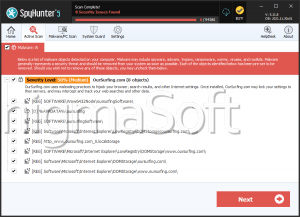Ursu Trojan
Threat Scorecard
EnigmaSoft Threat Scorecard
EnigmaSoft Threat Scorecards are assessment reports for different malware threats which have been collected and analyzed by our research team. EnigmaSoft Threat Scorecards evaluate and rank threats using several metrics including real-world and potential risk factors, trends, frequency, prevalence, and persistence. EnigmaSoft Threat Scorecards are updated regularly based on our research data and metrics and are useful for a wide range of computer users, from end users seeking solutions to remove malware from their systems to security experts analyzing threats.
EnigmaSoft Threat Scorecards display a variety of useful information, including:
Ranking: The ranking of a particular threat in EnigmaSoft’s Threat Database.
Severity Level: The determined severity level of an object, represented numerically, based on our risk modeling process and research, as explained in our Threat Assessment Criteria.
Infected Computers: The number of confirmed and suspected cases of a particular threat detected on infected computers as reported by SpyHunter.
See also Threat Assessment Criteria.
| Ranking: | 999 |
| Threat Level: | 90 % (High) |
| Infected Computers: | 104,047 |
| First Seen: | September 15, 2015 |
| Last Seen: | September 29, 2023 |
| OS(es) Affected: | Windows |
Ursu is a threatening Trojan that infiltrates your computer without your knowledge or consent, often by exploiting system vulnerabilities and security flaws. It can be downloaded from corrupted websites or email attachments from untrusted sources. The weaponized files can be from various different types, such as .exe, .pif, .avi and even .jpg files.
Once installed, Ursu remains hidden in the background and will likely perform various harmful functions that allow threat actors to gain complete control over the victim's system. The threatening capabilities of the Ursu Trojan may include deleting files, installing additional malware, collecting passwords, changing system settings and monitoring the computer activity. As Ursu does not have the ability to replicate itself, computer users need to take measures to protect their machines against it to prevent its installation on their computers.
Table of Contents
How Harmful are Threats Like the Ursu Trojan
A Trojan threat is malware that could be injected into or disguised as legitimate software or files, which is usually spread via file sharing, downloads or emails. Once inside your computer, it can cause damage by disabling system functions, hijacking personal information, accessing other devices connected to the network or providing its operators with remote access to the breached device.
Typically, Trojans are used to give hackers access to a user's device, taking control of its resources and opening up opportunities for further attacks, such as ransomware and data theft. In some cases, they are deployed by hackers to create Distributed Denial-of-Service (DDoS) attacks on networks and websites. Alternatively, they may be used to install additional threatening software onto PCs, such as keyloggers, crypto-miners, etc.
How to Avoid the Ursu Trojan Attacks?
Keeping all installed programs up-to-date helps protect against security vulnerabilities targeted by attackers. This applies not only to your operating system but also to any applications you might have, such as browsers or email clients. Routinely backing up essential data could provide an easy way to restore lost data in case something happens due to the effects of a harmful tool infiltrating your machine.
It also is crucial always to be careful when clicking links sent through unsolicited emails – this tactic is often employed by attackers trying to trick users into downloading corrupted files. If you receive suspicious emails containing attachments from unknown senders, try not to interact with them until you have managed to verify the legitimacy of their senders.



